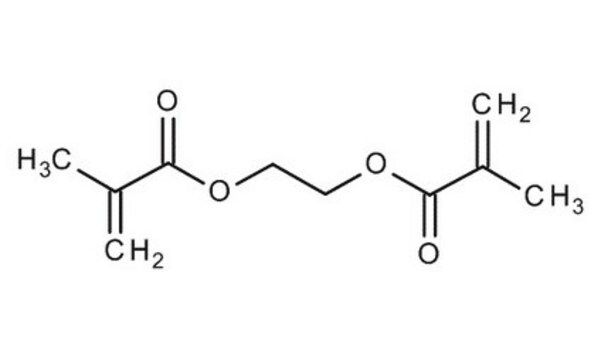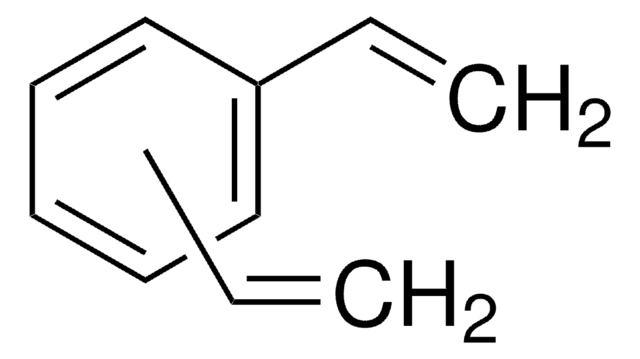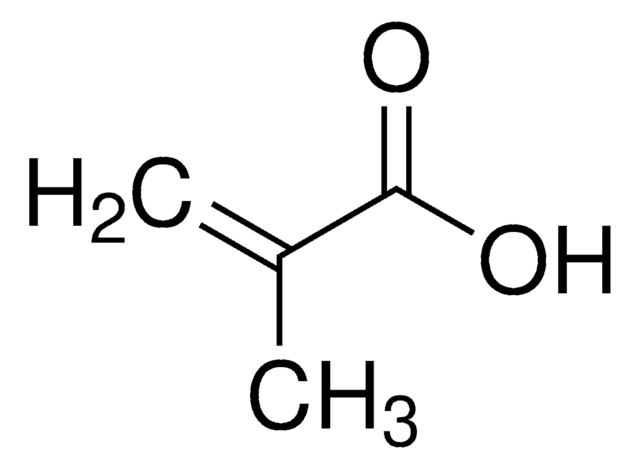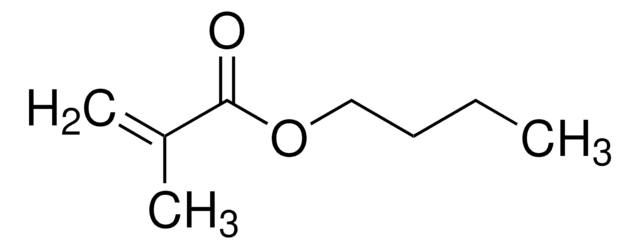335681
ジメタクリル酸エチレングリコール
98%, cross-linking reagent polymerization reactions, methacrylate, 90-110 ppm monomethyl ether hydroquinone as inhibitor
別名:
ジメタクリル酸1,2-エタンジオール, ジメタクリル酸エチレン
About This Item
おすすめの製品
製品名
ジメタクリル酸エチレングリコール, 98%, contains 90-110 ppm monomethyl ether hydroquinone as inhibitor
蒸気密度
>1 (vs air)
品質水準
蒸気圧
<0.1 mmHg ( 21.1 °C)
アッセイ
98%
フォーム
liquid
含みます
90-110 ppm monomethyl ether hydroquinone as inhibitor
反応適合性
reagent type: cross-linking reagent
reaction type: Polymerization Reactions
屈折率
n20/D 1.454 (lit.)
bp
98-100 °C/5 mmHg (lit.)
密度
1.051 g/mL at 25 °C (lit.)
Ω末端
methacrylate
α末端
methacrylate
ポリマー構造
shape: linear
functionality: homobifunctional
保管温度
2-8°C
SMILES記法
CC(=C)C(=O)OCCOC(=O)C(C)=C
InChI
1S/C10H14O4/c1-7(2)9(11)13-5-6-14-10(12)8(3)4/h1,3,5-6H2,2,4H3
InChI Key
STVZJERGLQHEKB-UHFFFAOYSA-N
類似した製品をお探しですか? 訪問 製品比較ガイド
詳細
アプリケーション
- ターポリマー系のポリ(アクリロニトリル-co-エチレングリコールジメタクリレート-co-ビニルベンジルクロリド)。医薬品吸着の吸着剤として応用できます。
- フリーラジカル共重合によるポリビニルアルコール(PVA)ベースのハイドロゲル。これらのPVAポリマーネットワークは、薬物送達システムとして使用できます。
シグナルワード
Warning
危険有害性情報
危険有害性の分類
Skin Sens. 1 - STOT SE 3
ターゲットの組織
Respiratory system
保管分類コード
10 - Combustible liquids
WGK
WGK 1
引火点(°F)
219.2 °F - Pensky-Martens closed cup
引火点(℃)
104 °C - Pensky-Martens closed cup
個人用保護具 (PPE)
Eyeshields, Faceshields, Gloves, type ABEK (EN14387) respirator filter
適用法令
試験研究用途を考慮した関連法令を主に挙げております。化学物質以外については、一部の情報のみ提供しています。 製品を安全かつ合法的に使用することは、使用者の義務です。最新情報により修正される場合があります。WEBの反映には時間を要することがあるため、適宜SDSをご参照ください。
消防法
第4類:引火性液体
第三石油類
危険等級III
非水溶性液体
労働安全衛生法名称等を表示すべき危険物及び有害物
名称等を表示すべき危険物及び有害物
労働安全衛生法名称等を通知すべき危険物及び有害物
名称等を通知すべき危険物及び有害物
Jan Code
335681-10L:
335681-BULK:
335681-5ML:
335681-100ML:
335681-VAR:
335681-500ML:
この製品を見ている人はこちらもチェック
資料
The manufacture of monomers for use in ophthalmic applications is driven by the need for higher purity, improved reliability of manufacturing supply, but ultimately by the need for the increased comfort, convenience, and safety of contact lens wearers. Daily wear contact lenses have the potential to fill this need for many customers; however, their widespread use is constrained by higher costs compared to weekly- or monthly-based lenses. New approaches that improve cost structure and result in higher quality raw materials are needed to help make contact lenses more affordable and accelerate growth of the contact lens market.
The manufacture of monomers for use in ophthalmic applications is driven by the need for higher purity, improved reliability of manufacturing supply, but ultimately by the need for the increased comfort, convenience, and safety of contact lens wearers. Daily wear contact lenses have the potential to fill this need for many customers; however, their widespread use is constrained by higher costs compared to weekly- or monthly-based lenses. New approaches that improve cost structure and result in higher quality raw materials are needed to help make contact lenses more affordable and accelerate growth of the contact lens market.
Global Trade Item Number
| カタログ番号 | GTIN |
|---|---|
| 335681-500ML | 4061837887062 |
| 335681-100ML | 4061837887048 |
| 335681-5ML | 4061826740200 |
ライフサイエンス、有機合成、材料科学、クロマトグラフィー、分析など、あらゆる分野の研究に経験のあるメンバーがおります。.
製品に関するお問い合わせはこちら(テクニカルサービス)










